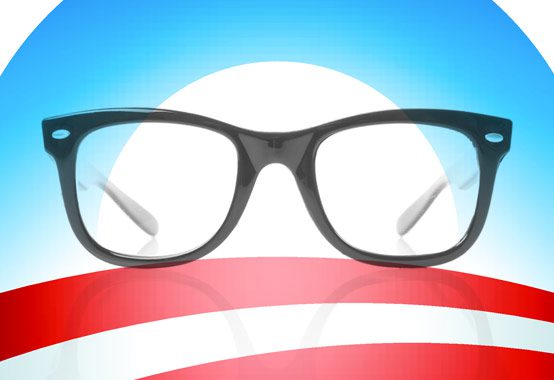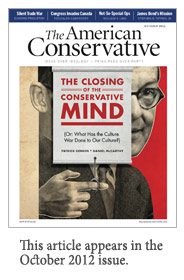Obama’s Nerds

Like football, the 2012 election is a game of inches. Heading into the fall, the presidential election remains close nationally. Every vote will count.
Enter Sasha Issenberg’s The Victory Lab, which posits that GOTV, or getting out the vote, is where elections are won or lost. According to Issenberg, “microtargeting” is now the byword of successful campaigns. He also observes that American politics is riven by ideological conflict, that policy preferences do matter (particularly among better-educated voters), and that it was not always that way. But The Victory Lab’s subtitle overstates: none of these things are very secret.
For example, the last presidential election won by a landslide was three decades ago, when Ronald Reagan was re-elected with just under 59 percent of the vote. Since then, candidates have struggled to take an actual majority of the popular vote and to win by a margin that does not look like an accident. No candidate since Reagan has enjoyed a winning margin of 10 percent or more.
Putting things into perspective, Barack Obama was the first successful candidate since George H. W. Bush in 1988 to win an absolute majority of the popular vote and a comfortable cushion. Obama beat John McCain by 7.3 points. George H.W. Bush had bested Mike Dukakis 53.3 to 45.6.
In contrast, Bill Clinton never broke the 50 percent mark in his two presidential bids. Al Gore won the popular vote in 2000 with only 48.38 percent of all votes cast. In 2004, George W. Bush crossed the 50 percent threshold, with 50.7 percent of the vote, a meager 2.4 percent margin over Massachusetts Democrat John Kerry.
Elections have clearly changed. The issueless politics of the 1950s, as Issenberg describes it, has given way to the politics of cleavage and confrontation. At the same time, the electorate’s warring factions are now at numerical and demographic parity.
With these changes afoot, it is not surprising that a campaign’s ability to identify supporters, persuade wavering voters, and then get both to the polls on Election Day has become ever more important. Issenberg stresses that in-person outreach, peer pressure, and direct mail have emerged as the preferred vehicles for reaching a targeted voter. Television no longer delivers the same bang for the buck.
For example, The Victory Lab recounts how on the last weekend before the 2004 election, the Bush campaign sent out a four-page targeted mailer to select mailboxes across the country that questioned Kerry’s toughness, his ability to lead the country at a time of war, and his commitment to getting Osama bin Laden. The Bush campaign itself viewed the mailer as over-the-top. But Bush strategist Alex Gage saw the last-minute flyer as having just the right visceral pitch to woo potential Bush voters who had doubts about both candidates. To Team Bush, it was terror and war—and not social issues—that carried their man past the finish line first.
On the other hand, the Bush campaign also had its failures. It mailed leaflets highlighting the president’s Clean Skies Initiative to upscale voters in Pennsylvania’s Main Line suburbs. Other leaflets went to Minnesota farmers, seeking to assuage their concerns about sugar beets and free trade. Yet Bush lost both Pennsylvania and Minnesota. Even microtargeting has limits.
The ground game also looms large for both parties. According to Issenberg, Election Day field operations were not a traditional GOP strength. Republican turnout strategy counted more on message and mechanics than on actual human contact. Phone banks and door-to-door volunteers armed with clipboards and smiles were more the stuff of unions, students, and Democratic operatives. By contrast, the Republican field operation was rich in congressional staffers and lobbyists.
The 2004 Bush campaign aimed to change things by putting boots on the ground early. During the summer of 2004, the Republican National Committee established a “Test Drive for W” operation to gear up for the fall campaign. Voters identified as Bush supporters received three rounds of contact in person and by phone from September onward. In the end, George W. Bush eked out the re-election that had eluded his father.
In politics and in war, winning techniques do not stay secret for long. Mark Halperin and John Harris wrote in their 2007 book, The Way to Win: Taking the White House in 2008, of how the Bush 1988 campaign used opposition research to come roaring back after being down 17 points to Mike Dukakis and then how the 1992 Clinton campaign further refined opposition research with his War Room’s rapid-response operation. Successful campaign tactics have a bipartisan life of their own.
Enter the Obama 2008 campaign, which took microtargeting to a whole new level, according to Issenberg. In addition to Obama’s much-ballyhooed presence in social media, the Obama campaign made a conscious decision to buy advertising on select bus routes in ten cities located in swing states, including buses in Philadelphia, Miami, Denver, Flint, and Akron. This way, Obama’s demographic core would be continuously and silently reminded to vote for him.
Per Issenberg’s telling, Team Obama was haunted by their rust-belt primary losses to Hillary Clinton. For the most part, she outperformed Obama in the swing states. The Obama campaign knew that Pennsylvania and Michigan would be fall battlegrounds and that Ohio had gone with the winner of every presidential election since 1960. To help fix things, the Obama campaign opened a hundred field offices in Ohio, including five offices in Cuyahoga County. Enthusiastic Democratic voters with a history of reliable turnout were wooed to become volunteer leaders. Volunteer-leader metrics were continuously monitored.
The Ohio volunteer effort was augmented by phone banks, canvassing, and data coordination. On Election Day 2008, Ohio and the rest of the rust belt went for Obama. He even picked off traditionally Republican Indiana. Obama overcame his Midwest and rust-belt primary losses and won Ohio by four points.
The scale and success of Obama’s ground game becomes apparent when compared to the efforts of Team McCain, a comparison Issenberg does not explicitly make. According to an analysis by Micah Cohen of the New York Times’s FiveThirtyEight blog, Obama had more than 700 field offices, which were concentrated in the swing states. McCain had fewer than 400 field offices nationwide. The results of the election tell it all. Local presence made a real difference.
Issenberg sheds light on the nexus between academe and the Democratic Party. The fact that university faculty and administrators swooned over Obama in 2008 is no secret. According to the Open Secrets campaign-contributions database, Columbia University employees donated more than $460,000 to the 2008 Obama campaign. Harvard donated more than $573,000 in the same cycle, including the $4,600 given by Elena Kagan, who went on to serve as Obama’s solicitor general and now sits on the Supreme Court. The story was pretty much the same out west. Stanford donated nearly $450,000 to Obama.
But academic involvement in Democratic politics was more than a matter of money. It was a matter of personal conviction, talent, and culture. According to The Victory Lab, the Obama campaign came to rely on the Consortium of Behavioral Scientists—in Issenberg’s words, a “Fight Club” of 29 psychologists, economists, and law professors dedicated to sending Democrats to Congress and electing a Democrat president. Consortium members dared not utter the group’s name in front of strangers. Like the title of Richard Thaler and Cass Sunstein’s 2008 book, Nudge, the consortium’s favored techniques involved peer pressure and behavioral modification. The candidate was a product and the electorate was a lab rat.
Thaler and Sunstein, then of the University of Chicago, were consortium members. Tellingly, Sunstein would be tapped by President Obama to serve as the head of the White House Office of Information and Regulatory Affairs (OIRA); marry Samantha Power, now a special assistant to the president and a member of the National Security Council staff; and depart the White House for a post at Harvard. Other consortium members included Nobel laureate Daniel Kahneman of Princeton and Max Bazerman of Harvard’s Kennedy School.
Issenberg wrongly attributes the political mobilization of these academics simply to their revulsion towards Bush 43. The fact is that America’s universities have been moving Democratic since the New Deal. Eugene McCarthy’s 1968 presidential campaign rested on college kids who went clean for Gene. In 1984, Columbia University President Michael Sovern played Ronald Reagan in Walter Mondale’s debate prep. Since Bill Clinton’s 1992 campaign, Americans with graduate degrees have consistently voted for the Democratic presidential candidate and academics have long had a soft spot for Democrats. The consortium was really emblematic of the New Class and reflected shifts in American politics and society that had been underway even during the supposedly sleepy 1950s.
Consortium members peppered Democratic leaders with memos that stressed what behavioral science could do for politics. Issenberg reports on a meeting between consortium leaders and Harry Reid and Hillary Clinton, among others, at which the senators were advised to stress voters’ sense of loss and to avoid speaking to their aspirations. According to the consortium, gloom and resentment could be turned into a winning hand. The Obama campaign came to rely upon the consortium in shaping its message and getting out the vote.
The Victory Lab has its shortcomings. It does not give the reader a clear sense of what comes next. The book plunks down in the midst of the 2010 election cycle and immediately describes the battle for the U.S. Senate seat from Colorado. Issenberg narrates how a last-minute blitz of nuanced emails and letters sent in white envelopes delivered a 15,000 vote victory to Democrat Michael Bennet. Then, the book jarringly reels backwards in time to 1919, the University of Chicago, political science, and the art of campaigning. All of this is informative. But the transition could have been smoother.
Issenberg does not give sufficient attention to why candidates lose. He appears to downplay the diagnosis of the late Republican pollster Robert Teeter and his colleague Fred Steeper that George McGovern lost in 1972 because he struck voters as being unable to “handle” the issues, rather than on account of his ideology.
 One only has to look at the failed 2012 presidential candidacy of Rick Perry to be reminded that perception of ability still matters. During the Republican debates, Perry was unable to remember the names of the cabinet departments that he had vowed to abolish and came across as a loutish and charmless caricature of George W. Bush. Ironically, Perry’s campaign was run was by Dave Carney, and both Perry and Carney are lauded in The Victory Lab for microtargeting Perry’s message during his campaigns for Texas governor. Competence still matters.
One only has to look at the failed 2012 presidential candidacy of Rick Perry to be reminded that perception of ability still matters. During the Republican debates, Perry was unable to remember the names of the cabinet departments that he had vowed to abolish and came across as a loutish and charmless caricature of George W. Bush. Ironically, Perry’s campaign was run was by Dave Carney, and both Perry and Carney are lauded in The Victory Lab for microtargeting Perry’s message during his campaigns for Texas governor. Competence still matters.
Issenberg concludes by conceding that the 2012 election will be less about persuading swing voters, who have grown disillusioned with Obama and the economy, and more about changing the demographics of the electorate with a particular emphasis on minorities and women. Issenberg is right. These days both Democrats and Republicans are actively engaged in voter suppression, according to Thomas Edsall of Columbia’s Journalism School. The culture wars remain ever with us.
Lloyd Green was opposition research counsel to the George H.W. Bush campaign in 1988 and served in the Department of Justice between 1990 and 1992.
Comments